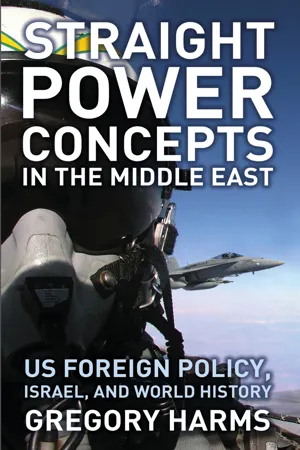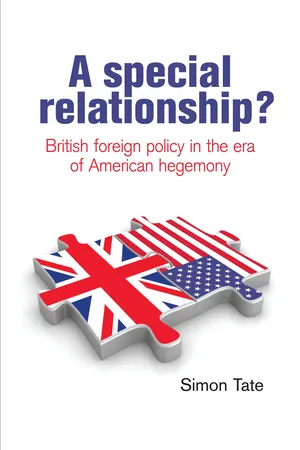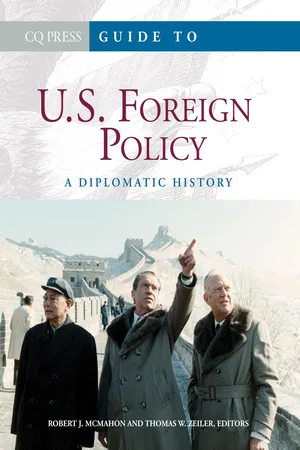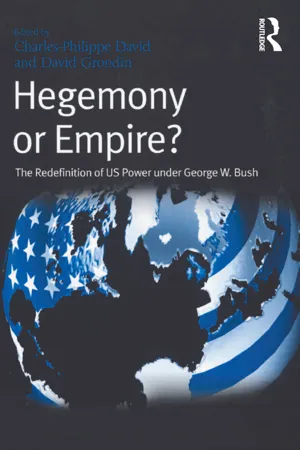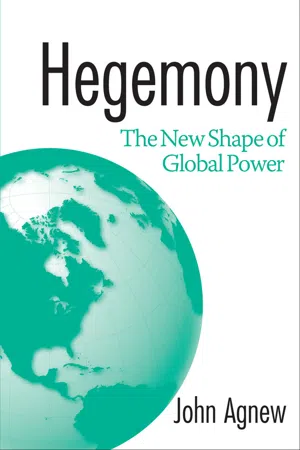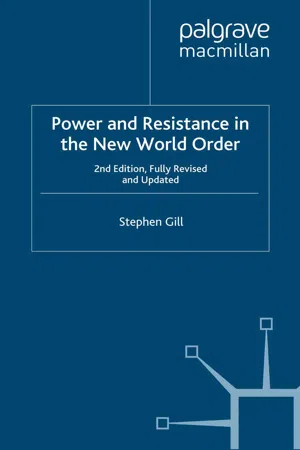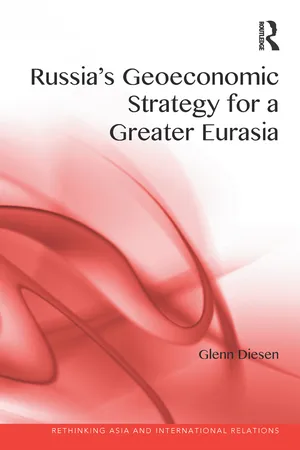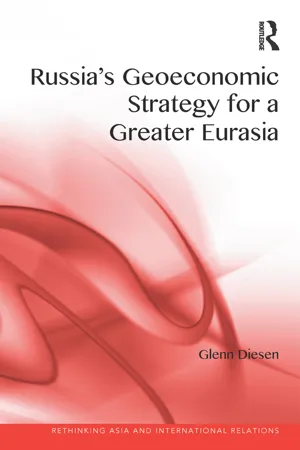History
Emergence of USA as a World Power
The emergence of the USA as a world power refers to the period in the late 19th and early 20th centuries when the United States experienced significant economic, political, and military growth, leading to its status as a dominant global player. This transformation was marked by territorial expansion, industrialization, and involvement in international affairs, culminating in the country's emergence as a leading force in world politics and economics.
Written by Perlego with AI-assistance
Related key terms
1 of 5
10 Key excerpts on "Emergence of USA as a World Power"
- eBook - PDF
Straight Power Concepts in the Middle East
US Foreign Policy, Israel and World History
- Gregory Harms(Author)
- 2010(Publication Date)
- Pluto Press(Publisher)
THE RISE OF AMERICAN POWER 35 propounded by Mahan, Turner, and many others reflected the national interest—from the perspective of power, also known in international relations as the “reason of state” ( raison d’état ). Foreign military venture, it rates mention, was hardly a novel concept in the United States. According to a continually updated Congressional Research Service bulletin, roughly 50 counts of foreign US military activity are noted in the 1800–50 period. 31 However, this activity never amounted to long-term hegemony in a given area or region. The “vigorous contest” did not become an endeavor in earnest until the turn of the century. Though the assortment of factors, forces, and opinions that moved the country in the direction of overseas expansion do inform the issue, we might invoke what students of philosophy know as Occam’s Razor: the principle that plurality should not be posited without necessity. In other words, simplicity in explanation tends to take precedence over multiplicity. While human (individual and group) decision making is a complex subject, from its inception the national agenda was forged by small groups of mostly like-minded individuals in places of power and privilege. As Thomas Hietala plainly says about the events of the 1840s in the preface of his revised edition of Manifest Design : What mainly propelled United States expansion? I still think the evidence points to the fears and ambitions of a small corps of American political figures, not to threats from abroad or demands from pioneers. This perspective rankles because it is inconsistent with American exceptionalism—the belief that the nation’s politics and diplomacy have been uniquely altruistic, open, and therefore beyond reproach. 32 Historian William Appleman Williams also draws the appropri-ately simple conclusions based on the historical evidence in his influential analysis, The Tragedy of American Diplomacy . - eBook - PDF
The European Union and World Politics
Consensus and Division
- A. Gamble, D. Lane, A. Gamble, D. Lane(Authors)
- 2009(Publication Date)
- Palgrave Macmillan(Publisher)
A strong realist strand in American thinking associated with Theodore Roosevelt, John Hay, Alfred Mahan and others now asserted itself, and new military doctrines and a new strategic awareness came to characterise an important part of the political class. 3 US participation in two world wars, which firmly established it as a world power, was therefore based on an experience of seeking and controlling first a continental empire and secondly a growing sphere of influence. The United States was never an imperial power in the sense of possessing extensive over- seas colonies which it directly administered, but it was not devoid of them either, and it played the great power game for spheres of influence as ruth- lessly as its European counterparts. Following the Second World War the United States in its bid to contain the Soviet Union embarked on a far- reaching policy of containment which ultimately led to a permanent US presence overseas, with 750 bases, 1.5 million personnel, and huge budgets for military equipment, which locked major sectors of the US economy into The United States and the EU: The End of Hegemony? 17 the new industrial military complex. 4 For proponents of the thesis that the US is now an empire, and relates to the rest of the world as an empire, and indeed the only significant empire that still functions, the vast US military deploy- ment is the surest evidence of it. The failure of the deployment to contract once the ostensible reason for it, the need to contain the Soviet Union and its allies, had disappeared is often cited as proof that the deployment has devel- oped its own rationale, and is geared to maintaining US supremacy in every part of the globe. 5 It is the permanence of the bases that suggests an empire, by giving the US the ability to intervene or apply pressure wherever it wants. If the term empire is restricted to direct control and administration of ter- ritory by the imperial power, then the US is no empire. - eBook - PDF
A special relationship?
British foreign policy in the era of American hegemony
- Simon Tate(Author)
- 2024(Publication Date)
- Manchester University Press(Publisher)
1 British governments’ perceptions of power and leadership in the world order since the 1940s In the 1990s it was not uncommon for academic texts to question the strength of American hegemony. Books, such as Joseph Nye’s Bound to Lead: The Changing Nature of American Power ( 1990) and Stephen Burman’s America in the Modern World: the Transcendence of United States Hegemony ( 1991 ), asked whether American administrations still had the desire and the capability to pursue active foreign policy roles which led the world. More recently, American actions in the global political arena since September 11, 2001, have again brought to prominence debates over the strength of American hegemony. However, the tone has changed. For example, Michael Cox asks ‘Whatever Happened to American Decline?’ (2001); John Ikenberry considers how ‘the United States began the 1990s as the world’s only superpower and its advantages continued to grow through the decade’ (Ikenberry, 2004, p. 83); and Peter Gowan argues that ‘the US drive to remilitarise world politics [is] the basis for consolidating its global hegemony’ (2004, p. 76; see also Arrighi, 2005; Bellamy Foster, 2006). Such assertions as to the nature and strength of US hegemony are important because, as Held and Koenig-Archibugi (2004) elucidate, the way in which America uses this power has repercussions for every major issue of international affairs, including the future of the special relationship, prospects for regional security in the Middle East and the spread of democratic governance. These contributions are also indicative of the fact that the focus - eBook - PDF
Guide to U.S. Foreign Policy
A Diplomatic History
- Robert J. McMahon, Thomas W. Zeiler, Robert J. McMahon, Thomas W. Zeiler(Authors)
- 2012(Publication Date)
- CQ Press(Publisher)
143 ★ b y M a r k B e n b o w w i t h A n d r e w D e R o c h e c h a p t e r 1 0 Diplomatic Milestones, 1898–1919 History and Analysis of the Nation’s Emergence as a World Power and Society’s Reaction B etween 1898 and 1919, the United States emerged as a world power and expanded beyond its shores into areas including Hawaii, Cuba, the Philippines, and Panama. The most influential U.S. policymakers of the era, especially Presidents Theodore Roosevelt (1901–1909), William Howard Taft (1909–1913), and Woodrow Wilson (1913–1921), each followed policies that further moved the United States onto the world stage as one of the influential major powers. While the policies of each leader differed in some ways from those of his predeces-sor, all shared underlying commonalities that demonstrated how the nation’s foreign policy evolved from American actions prior to 1898. Moreover, the policies of the three Progressive Era presidents established precedents that their successors utilize even today. At the root of all three leaders’ policies lay a series of ideological assumptions about the superiority of a democratic political system, a capitalist economy, and the need for the United States to be proactive in protecting its national security interests beyond its continental boundaries, using both the threat of and the actual use of military force. A racial component, an idea of white supremacy, also played a role in the nation’s foreign policy, with each presi-dent assuming, as did most Americans, that Anglo-Saxon males were the apogee of society. However, Wilson, for his part, believed that all people were fit for self-government. Such a stance revealed that there were sometimes enormous differences in opinion among the three presidents over the forms that the ideal democratic government should take, or what, exactly, made up a capitalist economy. In addition, at times, each firmly opposed the others’ policies and faced opposition from outside forces as well. - eBook - ePub
Hegemony or Empire?
The Redefinition of US Power under George W. Bush
- David Grondin, Charles-Philippe David(Authors)
- 2016(Publication Date)
- Routledge(Publisher)
Chapter 1Theory Wars of Choice: Hidden Casualties in the ‘Debate’ Between Hegemony and Empire
Robert VitalisFor analyses of world politics since the George W. Bush administration’s overthrow of the Taliban in Afghanistan and of Saddam Hussein in Iraq, the main hypothesis to be tested and if possible rejected is that the moment is one in which an old world order is dying and a new world order is being born. Thus it is easy to imagine a few of the key debates in advance. Some will argue for the signal importance of 9/11. Others will argue that the changes were obvious or nascent or incipient before the attacks on New York and Washington. Still others will argue that none of what we proclaim to be new is in fact new save at the margins, and certainly not in how power is being wielded and for what objectives. And though it won’t be a main question among students of international relations, you can also imagine the argument turned on its head. We are witnessing a radical transformation in the American political economy, what Walter Dean Burnham calls with reference to earlier moments, the 1890s and 1930s, a ‘critical realignment’.1 Answering questions such as these correctly or even asking the right questions hinges on an adequate understanding of the institutions that make up the contemporary world system. The problem is that many journalists, scholars and activists have gotten it more wrong than right in lining up against the new, so-called American ‘wars of choice’. Consider the confusion that emerges in discussions of something called empire and something else called hegemony. There are at least two kinds of analytical errors in current writings. One is the routine treatment of the two terms as synonyms, ignoring or ignorant of the work, starting with Immanuel Wallerstein, that shows how these two modes of international domination are different from one another.2 - eBook - PDF
Hegemony
The New Shape Of Global Power
- John Agnew(Author)
- 2005(Publication Date)
- Temple University Press(Publisher)
39 First, U.S. hegemony has been based on a rejection of territorial limits to its influence, as would necessarily come with empire. In this sense it has been a nonterritorial enterprise, notwithstanding pe-riods when territorial strategies have been pursued, such as during the Spanish-American War. The United States is not just one on a long list of hegemons achieving global “power” and then all behaving the same way. In previous epochs, such as that of British hegemony in the nine-teenth century, the influence exerted was much more geographically circumscribed. Indeed, Britain had little or no hegemony in Europe. Outside of Europe its empire was central to its enterprise, although there was considerable investment in and trade with the United States, Latin America, and elsewhere as well. The whole world has become America’s oyster, so to speak, particularly since the end of the Cold War has brought even its erstwhile challengers such as Russia and China within its cultural-economic orbit. Second, American hegemony has been a potent brew of cultural and political-economic doctrines and rules of conduct that are usually the outcome of assent and cooperation more than direct coercion. Except American Hegemony and the New Geography of Power 53 among certain groups of “anglophiles,” the British never had close to the same influence around the world. More important, to see the result-ing globalization as simply based on coercion is profoundly mistaken. It is the result of the self-mobilization of people around the world into practices, routines, and outlooks that they not only accept but think of as their own. This has been the “genius” of U.S. hegemony: to enroll others in its exercise. But this brew did not simply appear out of thin air once the United States came to use its power resources to make itself a global superpower. - eBook - PDF
Power and Resistance in the New World Order
2nd edition, Fully Revised and Updated
- S. Gill(Author)
- 2008(Publication Date)
- Palgrave Macmillan(Publisher)
Chapter 5 argues that orthodox perspectives, for example those of Realist and World-Systems The Political Economy of World Order 75 schools have limited theorization of important transformative processes in the global political economy , with the result that their assessments of the nature and prospects for hegemony in world order can be queried. More to the point, hegemony is not to be understood as simply a relation of dominance between states in the interstate system; it involves the construction of a relatively consensual form of politics within its sphere of reference, with its combination of power and leadership giving due weight to subordinate forces in a series of institutionalized political set- tlements. Hegemony is forged in a complex set of historical blocs that link public and private power within and across nations in transna- tional political networks that seek to sustain, regulate and rule an increasingly global capitalist order. Thus the issue is not so much the decline of American hegemony; rather the question is how far and in what ways hegemony is being reconstituted, in a historical process that involves continuity and dis- continuity, limits and contradictions. Indeed the argument of the essay is based upon the proposition that not only is US power unparalleled in comparison to earlier hegemonies but also, and perhaps more impor- tantly, it combines material and normative capacities and potentials in a new, modernist cultural and institutional framework that serves to channel and direct changes in identification and practice across territo- rial jurisdictions – often in ways that promote the interests of large corporate capital, and the interests of American corporations in particu- lar. Thus, the power and inf luence of elements in American political and civil society have been significant in shaping and reshaping the post-war international economy, which has become increasingly globalized. - Glenn Diesen(Author)
- 2017(Publication Date)
- Routledge(Publisher)
2 The rise, decline and potential revival of US geoeconomic power Introduction The rise, decline and potential revival of US geoeconomic power are surveyed as indicators for both opportunities and challenges in Russia’s external environment. The US is the principal balancer of Russia and has strategic interests diametrically opposed to economic connectivity between major Eurasian land powers such as Russia, China, Germany and Iran. The dominant military power of the US has ensured control over key transportation corridors and strategic resources, while monetary and ¿nancial clout produces control over key chokepoints in the global economy. The relative decline of US geoeconomic power produces systemic incentives for rivals to challenge the status quo, yet the US still has opportunities to resuscitate some of its former geoeconomic authority. This chapter will ¿rst explore the rise and decline of US geoeconomic power. The US has since the late 1800s performed remarkably as a geoeconomic maritime power by controlling strategic sea routes, thrived with trade and pursued inexpensive offshore balancing in Eurasia. The Second World War created systemic incentives for the US to expand its geoeconomic reach globally. Albeit, the war also produced a severely skewed balance of power in Eurasia and economic statecraft had limited impact on the Soviet Union as a communist state largely disconnected from international markets. America’s extensive and increasing militarisation to balance the Soviet Union led to its geoeconomic power regressing towards traditional geopolitics. The US did not reform and return to geoeconomics after the Cold War since military power was conceived as the main instrument to sustain the unipolar moment. The US has ample potential to revive its geoeconomic power, which could present both challenges and opportunities to Russia.- Glenn Diesen(Author)
- 2017(Publication Date)
- Taylor & Francis(Publisher)
2 The rise, decline and potential revival of US geoeconomic powerIntroduction
The rise, decline and potential revival of US geoeconomic power are surveyed as indicators for both opportunities and challenges in Russia’s external environment. The US is the principal balancer of Russia and has strategic interests diametrically opposed to economic connectivity between major Eurasian land powers such as Russia, China, Germany and Iran. The dominant military power of the US has ensured control over key transportation corridors and strategic resources, while monetary and financial clout produces control over key chokepoints in the global economy. The relative decline of US geoeconomic power produces systemic incentives for rivals to challenge the status quo, yet the US still has opportunities to resuscitate some of its former geoeconomic authority.This chapter will first explore the rise and decline of US geoeconomic power. The US has since the late 1800s performed remarkably as a geoeconomic maritime power by controlling strategic sea routes, thrived with trade and pursued inexpensive offshore balancing in Eurasia. The Second World War created systemic incentives for the US to expand its geoeconomic reach globally. Albeit, the war also produced a severely skewed balance of power in Eurasia and economic statecraft had limited impact on the Soviet Union as a communist state largely disconnected from international markets. America’s extensive and increasing militarisation to balance the Soviet Union led to its geoeconomic power regressing towards traditional geopolitics. The US did not reform and return to geoeconomics after the Cold War since military power was conceived as the main instrument to sustain the unipolar moment.The US has ample potential to revive its geoeconomic power, which could present both challenges and opportunities to Russia. The ‘shale revolution’ is set to make the US an energy exporter determined to undermine Russia’s position in Europe, while the TPP/TTIP trade agreements that have been berated and will probably be cancelled by the Trump administration would have been powerful economic tools to marginalise both China and Russia. The US is under mounting pressure to abandon the unipolar moment as it incentivises collective balancing of the US by major powers such as China, Russia and Iran. Accommodating Russia or China to a greater extent could be instrumental in restoring some division and an internal balance of power in Eurasia. Realist theory would expect that the US would increasingly abandon containment of Russia since China is the principal geoeconomic rival. However, the ability to contain Russia is greater, especially following the Ukraine crisis.- eBook - PDF
The Future of Global Relations
Crumbling Walls, Rising Regions
- T. Paupp(Author)
- 2009(Publication Date)
- Palgrave Macmillan(Publisher)
Introduction The close of the first decade of the twenty-first century marks both the cul- mination of an almost sixty-year-old world order dominated by the United States and the inauguration of a radically reconfigured one. In the parlance of historians, the twentieth century has been labeled the “American Century.” It is a term that represents a triumphalist rendering of the nature and scope of American power in the twentieth century. More specifically, it stands as testimony to America’s hegemonic role and dominance in the realm of global power politics. The gravitational pull of this idea has captured the fancy of ideologues and fanatics as much as policymakers and power brokers. From the entrenched power perspective of the Washington establishment, neocon- servatives, liberal hawks and other post–cold war elites, the assumption that guided them through the successive administrations was one that depicted the United States as destined to enjoy an extended unipolar moment. It was supposed to be a unipolar moment that would make the next one hundred years into the “New American Century.” However, the tide of time and events has started to reveal a different set of factors at work for the evolution of twenty-first century global power politics. The Thesis of the Book This book is dedicated to addressing two major trends in the evolution of world order politics in the early twenty-first century. These two trends con- stitute an interwoven thesis. The first thesis is that the twenty-first century is witnessing the end of American hegemony and the demise of its unipolar moment in U.S. foreign policy. The second thesis is how a multicentric or multipolar world of rising regional powers is coming into being and is bring- ing with it an end to American hegemony and all potential future hegemons.
Index pages curate the most relevant extracts from our library of academic textbooks. They’ve been created using an in-house natural language model (NLM), each adding context and meaning to key research topics.
